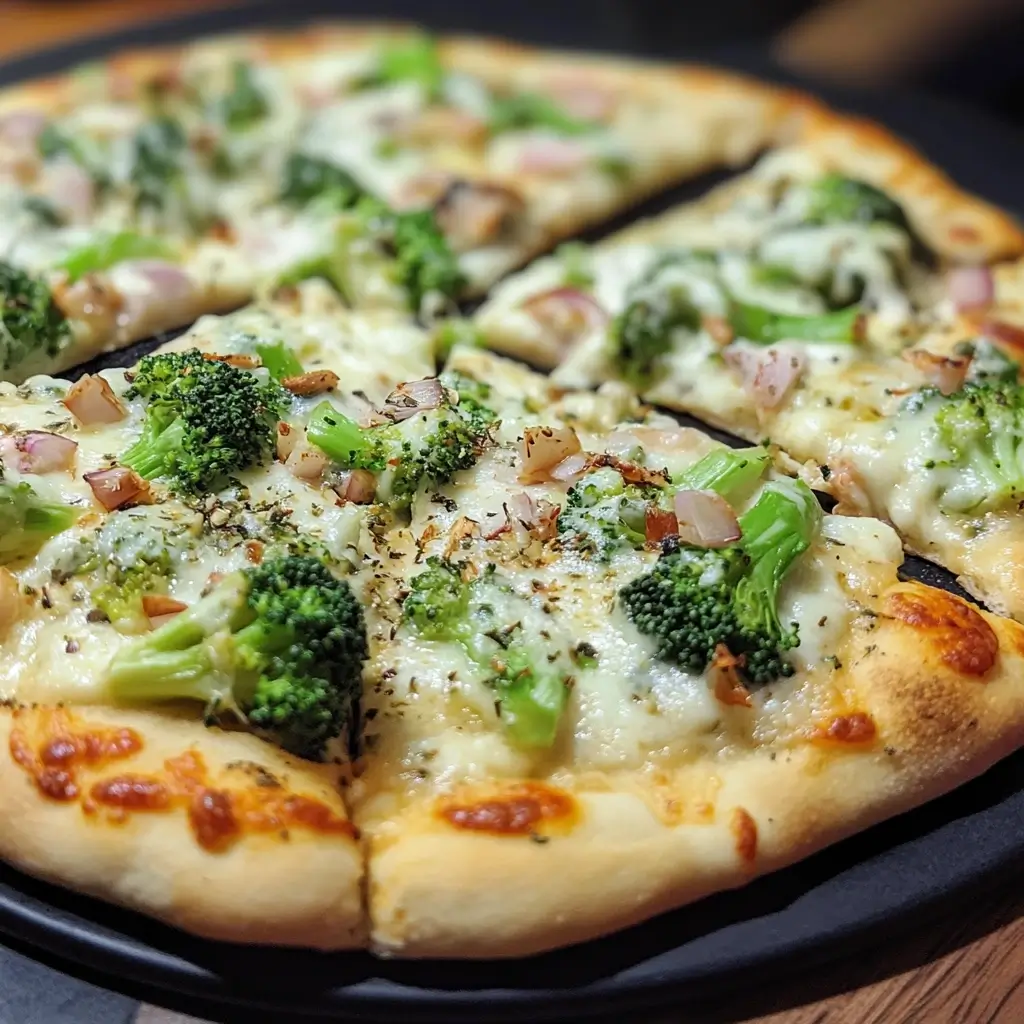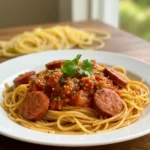There are some recipes that just instantly become part of the family repertoire, the ones requested week after week, the ones that disappear minutes after hitting the table. This Broccoli White Pizza is unequivocally one of those recipes in our house. I first made it on a whim, slightly skeptical about whether the kids would embrace a pizza heavily featuring a green vegetable. Pizza night is sacred, after all, and deviations from the classic pepperoni can sometimes be met with resistance. But the magic happened. The creamy, garlicky ricotta base, mingling with the melted mozzarella and nutty Parmesan, created a luxurious canvas. The broccoli, lightly blanched so it was tender but still had a slight bite, wasn’t seen as an intrusion but as a delicious component. Even my husband, a self-proclaimed red sauce loyalist, admitted defeat and declared it one of the best homemade pizzas he’d ever had. Since then, it’s become a go-to for easy weeknights, casual entertaining, and even “clean out the fridge” moments (though we always make sure to have broccoli on hand now!). It feels slightly sophisticated yet incredibly comforting, a perfect balance that satisfies everyone. Seeing the whole family happily devouring slice after slice, with little green flecks dotting cheesy smiles, is proof enough for me – this recipe is a keeper.
Broccoli White Pizza: Ingredients
This recipe yields one roughly 12-14 inch pizza, typically serving 3-4 people as a main course or 6-8 as an appetizer.
For the Pizza Dough:
- 1 pound (about 450g) pizza dough (store-bought or Homemade Pizza Dough – recipe below)
- 1-2 tablespoons all-purpose flour, for dusting
- 1 tablespoon olive oil, for the bowl (if using homemade and proofing)
For the Garlic Ricotta White Sauce:
- 1 cup (about 240g) whole milk ricotta cheese (good quality makes a difference!)
- 3-4 cloves garlic, minced (about 1 tablespoon)
- 2 tablespoons extra virgin olive oil
- 1/4 cup (about 25g) grated Parmesan cheese, plus more for garnish
- 1/4 teaspoon salt, or to taste
- 1/8 teaspoon black pepper, freshly ground
- Optional: Pinch of red pepper flakes for a little heat
- Optional: 1 tablespoon fresh chopped parsley or basil
For the Toppings:
- 1.5 – 2 cups (about 150-200g) small broccoli florets (cut from 1 medium head of broccoli)
- 1.5 cups (about 170g) shredded low-moisture mozzarella cheese (whole milk or part-skim)
- Optional: 1/4 cup crumbled feta cheese for extra tang
- Optional: Thinly sliced red onion (about 1/4 small onion)
For Finishing:
- 1 tablespoon extra virgin olive oil, for drizzling (optional)
- Additional grated Parmesan cheese
- Freshly ground black pepper
- Red pepper flakes (optional)
For Homemade Pizza Dough (Optional but Recommended):
- 1 teaspoon active dry yeast or instant yeast
- 3/4 cup (180ml) warm water (about 105-115°F or 40-46°C)
- 1 teaspoon granulated sugar or honey
- 2 cups (about 250g) all-purpose flour or bread flour, plus more for dusting
- 1 teaspoon salt
- 2 tablespoons olive oil, plus more for the bowl
Making Homemade Pizza Dough (Optional but Recommended)
While store-bought dough is convenient, homemade dough offers superior flavor and texture. If you have the time, give this simple recipe a try!
- Activate Yeast (if using active dry): In a small bowl, combine the warm water, sugar/honey, and active dry yeast. Let it sit for 5-10 minutes until foamy. If using instant yeast, you can skip this step and add it directly to the dry ingredients.
- Combine Dry Ingredients: In a large bowl or the bowl of a stand mixer fitted with a dough hook, whisk together the flour and salt.
- Mix Dough: Add the activated yeast mixture (or warm water, sugar/honey, and instant yeast) and 2 tablespoons of olive oil to the dry ingredients.
- By Hand: Stir with a wooden spoon until a shaggy dough forms. Turn the dough out onto a lightly floured surface and knead for 8-10 minutes until smooth and elastic. The dough should spring back slowly when poked.
- Stand Mixer: Mix on low speed until the dough comes together. Increase the speed to medium-low and knead for 5-7 minutes until the dough is smooth, elastic, and pulls away from the sides of the bowl.
- First Rise (Proofing): Lightly oil a large, clean bowl. Form the dough into a ball and place it in the oiled bowl, turning it once to coat the entire surface with oil. Cover the bowl tightly with plastic wrap or a clean kitchen towel. Let the dough rise in a warm place for 1-1.5 hours, or until doubled in size.
- Punch Down: Gently punch down the center of the risen dough to release the air. It’s now ready to be shaped for your pizza! You can also wrap it tightly in plastic wrap and refrigerate it for up to 3 days (the flavor actually improves with a cold ferment) or freeze it for longer storage. If refrigerated, let it sit at room temperature for 30-60 minutes before shaping.
Instructions: Assembling and Baking Your Broccoli White Pizza
Follow these steps carefully for pizza perfection!
- Preheat Oven & Prepare Baking Surface: Place a pizza stone or steel (highly recommended for a crispy crust) on an oven rack positioned in the lower third of your oven. If you don’t have one, use a heavy-duty baking sheet (place it in the oven now too). Preheat your oven to the highest temperature it can reach, typically 500-550°F (260-290°C), for at least 30-60 minutes. Getting the oven and the baking surface thoroughly heated is crucial for a good crust.
- Prepare the Broccoli: Bring a small pot of salted water to a boil. Add the broccoli florets and blanch them for just 60-90 seconds. Immediately drain the broccoli and plunge it into an ice bath (a bowl filled with ice and cold water) for a minute to stop the cooking process and retain its bright green color. Drain thoroughly and pat dry with paper towels. Excess moisture is the enemy of crispy pizza! Toss the dried florets with a tiny drizzle of olive oil and a pinch of salt and pepper, if desired.
- Prepare the Garlic Ricotta Sauce: In a medium bowl, combine the ricotta cheese, minced garlic, 2 tablespoons of extra virgin olive oil, 1/4 cup grated Parmesan cheese, salt, and black pepper. Stir well until smooth and creamy. Taste and adjust seasoning if necessary. Stir in the optional red pepper flakes or fresh herbs if using.
- Shape the Dough: Lightly flour your work surface and your hands. Place the pizza dough (either store-bought or your proofed homemade dough) on the floured surface. Gently press down in the center and work your way outwards, using your fingertips to stretch the dough into a 12-14 inch circle (or rectangle, if preferred). Try to create a slightly thicker rim for the crust. Avoid using a rolling pin if possible, as it can deflate the air bubbles crucial for a good texture. If the dough resists stretching, let it rest, covered, for 5-10 minutes, then try again.
- Prepare for Transfer: Lightly dust a pizza peel or the back of a baking sheet with flour or cornmeal. Carefully transfer the shaped pizza dough onto the prepared peel/baking sheet. Gently reshape it if needed.
- Assemble the Pizza:
- Spread the Garlic Ricotta White Sauce evenly over the pizza dough, leaving about a 1/2-inch border for the crust.
- Sprinkle about half of the shredded mozzarella cheese evenly over the ricotta sauce.
- Distribute the blanched and dried broccoli florets over the cheese. If using, scatter the optional thinly sliced red onion and crumbled feta cheese now.
- Top with the remaining shredded mozzarella cheese.
- Bake the Pizza: Carefully slide the assembled pizza from the peel/baking sheet onto the preheated pizza stone, steel, or baking sheet in the oven. Bake for 10-15 minutes, or until the crust is golden brown and puffed, and the cheese is melted, bubbly, and slightly golden in spots. Cooking time will vary depending on your oven temperature and the baking surface used. Keep a close eye on it after the 10-minute mark.
- Finish and Rest: Carefully remove the pizza from the oven using the pizza peel or tongs. Let it rest on a wire rack or cutting board for 3-5 minutes before slicing. This allows the cheese to set slightly and prevents toppings from sliding off.
- Garnish and Serve: Drizzle the pizza with the optional 1 tablespoon of extra virgin olive oil. Garnish with additional grated Parmesan cheese, a sprinkle of freshly ground black pepper, and optional red pepper flakes for those who like extra heat. Slice and serve immediately.
Nutrition Facts
- Servings: Approximately 8 slices (based on a 12-14 inch pizza)
- Calories per Serving (estimated): 350-450 kcal
Disclaimer: Nutritional information is an estimate only and will vary depending on the specific ingredients used (especially the type of dough, cheese fat content, and amount of oil), portion sizes, and any modifications made to the recipe. For precise nutritional data, it’s recommended to use a dedicated nutrition calculator with your exact ingredients. This pizza provides a good source of calcium from the cheeses and vitamins/fiber from the broccoli.
Preparation Time
- Active Preparation Time: 25-35 minutes (includes sauce prep, broccoli blanching, dough shaping, and assembly)
- Homemade Dough Rising Time (if applicable): 1 – 1.5 hours
- Oven Preheating Time: 30-60 minutes (essential step, overlaps with dough rising or prep)
- Baking Time: 10-15 minutes
- Total Time (using store-bought dough): Approximately 1 hour 5 minutes – 1 hour 50 minutes (including preheating)
- Total Time (using homemade dough): Approximately 2 hours 5 minutes – 3 hours 20 minutes (including rising and preheating)
How to Serve Your Broccoli White Pizza
This versatile pizza can be served in various ways, fitting different occasions:
- Classic Pizza Night:
- Slice into 8 traditional wedges.
- Serve hot and fresh from the oven.
- Pair with a simple green salad tossed with a light vinaigrette to balance the richness.
- Offer extra red pepper flakes and Parmesan on the side.
- Appetizer Style:
- Cut the pizza into smaller squares or thin rectangular strips (“party cut”).
- Arrange attractively on a platter.
- Ideal for gatherings, game days, or before a larger meal.
- Serve alongside other appetizers like chicken wings, bruschetta, or a veggie platter with dip.
- Lunch Pairing:
- Serve a slice or two alongside a bowl of soup (tomato soup or minestrone works well).
- A great option for using up leftovers.
- Elevated Dinner:
- Pair with a crisp white wine like Pinot Grigio, Sauvignon Blanc, or a dry Rosé.
- For beer lovers, a Pilsner or a light Pale Ale complements the flavors.
- Garnish generously with fresh basil or parsley just before serving for an extra touch of freshness and color.
- Family Style:
- Place the whole pizza (on a safe board) in the center of the table and let everyone serve themselves.
- Encourages sharing and a casual dining atmosphere.
Additional Tips for Pizza Perfection
- Achieve the Crispiest Crust: The secret lies in high heat and direct contact. Preheat your oven to its absolute maximum temperature with a pizza stone or steel inside for at least 30 minutes, preferably 60. The stone/steel absorbs and radiates intense heat, cooking the crust quickly from below, resulting in that coveted crispy, slightly charred base. If you don’t have one, preheating a heavy-duty baking sheet helps, but a stone/steel is superior. Also, ensure your dough isn’t too wet, and don’t overload the pizza with excessively moist toppings.
- Don’t Skip Blanching the Broccoli: While you can put raw broccoli on pizza, blanching offers several advantages. It tenderizes the florets slightly, ensuring they cook through perfectly in the hot oven without burning or remaining unpleasantly crunchy. It also helps lock in that vibrant green color. Most importantly, the subsequent ice bath and thorough drying step remove excess water, preventing a soggy pizza top.
- Master the Sauce Consistency: Use good quality whole milk ricotta for the creamiest, richest sauce. If your ricotta seems particularly watery, you can let it drain in a fine-mesh sieve lined with cheesecloth or a coffee filter for 30 minutes before mixing the sauce ingredients. The goal is a thick, spreadable paste, not a runny liquid. Taste and adjust seasoning before spreading it on the dough – it should be flavorful on its own.
- Cheese Choices Matter: Low-moisture mozzarella is key because it melts beautifully without releasing too much water. Fresh mozzarella balls, while delicious, contain much more water and are better suited for Neapolitan-style pizzas baked very quickly at extremely high temperatures. Shredding your own mozzarella from a block often yields better melting results than pre-shredded varieties (which can contain anti-caking agents). Don’t skimp on the Parmesan; its nutty, salty flavor is crucial for the white pizza profile.
- Proper Reheating Technique: Leftover pizza? Avoid the microwave if you want to maintain crispness! The best way to reheat is in a dry skillet over medium-low heat for a few minutes (cover the pan briefly to help melt the cheese) until the bottom is crisp and the pizza is heated through. Alternatively, reheat slices on a baking sheet in a moderate oven (around 375°F or 190°C) for 5-8 minutes until hot and re-crisped. An air fryer also works wonders for reheating pizza slices quickly.
Frequently Asked Questions (FAQ)
Q1: Can I use frozen broccoli instead of fresh?
A: Yes, you can use frozen broccoli florets, but proper preparation is essential. Do not blanch frozen broccoli. Thaw it completely first (either overnight in the refrigerator or by running under cool water). Once thawed, squeeze out as much excess water as humanly possible using paper towels or a clean kitchen towel. Frozen broccoli releases significantly more moisture than fresh, so getting it very dry is critical to prevent a soggy pizza. Chop the thawed, dried florets into small, bite-sized pieces before adding them to the pizza.
Q2: How can I make this pizza gluten-free?
A: Absolutely! The easiest way is to use your favorite store-bought gluten-free pizza crust. Follow the package instructions for pre-baking or preparation, if any, before adding the toppings. Alternatively, you can make your own gluten-free pizza dough using a reliable recipe that typically involves a blend of gluten-free flours (like almond, rice, tapioca) and a binder like xanthan gum. The sauce and toppings are naturally gluten-free, but always double-check the labels on your cheeses and any other additions to ensure they are certified gluten-free if cross-contamination is a concern.
Q3: Can I add meat or other vegetables to this pizza?
A: Yes, this recipe is a great base for customization!
- Meat: Cooked, crumbled Italian sausage, grilled chicken strips, or crispy prosciutto added after baking would be delicious additions. Ensure any raw meat is fully cooked before adding it to the pizza.
- Other Vegetables: Sautéed mushrooms, caramelized onions, roasted red peppers, sun-dried tomatoes, spinach (wilted and squeezed dry), or artichoke hearts would complement the broccoli and white sauce beautifully. Remember to pre-cook or prepare these vegetables appropriately to manage moisture content.
Q4: My pizza crust came out soggy in the middle. What went wrong?
A: Soggy crust is usually due to excess moisture or insufficient heat from below. Common culprits include:
- Oven/Stone Not Hot Enough: Ensure your oven and pizza stone/steel/sheet are fully preheated to the maximum temperature for at least 30-60 minutes.
- Wet Toppings: Did you thoroughly dry the blanched broccoli? Was your ricotta very watery? Did you use fresh mozzarella instead of low-moisture? Excess water from toppings seeps down and makes the crust steam instead of crisp.
- Sauce Too Thin: A watery sauce contributes to sogginess. Ensure your ricotta sauce is thick and spreadable.
- Dough Too Thick/Underbaked: If the center dough was too thick or the pizza wasn’t baked long enough, the bottom might not have cooked through.
- Overloading: Too many toppings, especially moist ones, can weigh down the dough and prevent crisping.
Q5: How long does leftover Broccoli White Pizza last, and what’s the best way to store it?
A: Leftover pizza should be cooled completely, then stored in an airtight container or wrapped tightly in plastic wrap or aluminum foil. It will keep in the refrigerator for up to 3-4 days. For longer storage, you can freeze slices. Wrap individual slices tightly in plastic wrap, then place them in a freezer bag or airtight container. Frozen pizza is best consumed within 1-2 months for optimal quality. Reheat using the skillet, oven, or air fryer methods described in the “Additional Tips” section for the best results (avoid the microwave if possible).
Print
Broccoli White Pizza Recipe
Ingredients
For the Pizza Dough:
- 1 pound (about 450g) pizza dough (store-bought or Homemade Pizza Dough – recipe below)
- 1–2 tablespoons all-purpose flour, for dusting
- 1 tablespoon olive oil, for the bowl (if using homemade and proofing)
For the Garlic Ricotta White Sauce:
- 1 cup (about 240g) whole milk ricotta cheese (good quality makes a difference!)
- 3–4 cloves garlic, minced (about 1 tablespoon)
- 2 tablespoons extra virgin olive oil
- 1/4 cup (about 25g) grated Parmesan cheese, plus more for garnish
- 1/4 teaspoon salt, or to taste
- 1/8 teaspoon black pepper, freshly ground
- Optional: Pinch of red pepper flakes for a little heat
- Optional: 1 tablespoon fresh chopped parsley or basil
For the Toppings:
- 1.5 – 2 cups (about 150-200g) small broccoli florets (cut from 1 medium head of broccoli)
- 1.5 cups (about 170g) shredded low-moisture mozzarella cheese (whole milk or part-skim)
- Optional: 1/4 cup crumbled feta cheese for extra tang
- Optional: Thinly sliced red onion (about 1/4 small onion)
For Finishing:
- 1 tablespoon extra virgin olive oil, for drizzling (optional)
- Additional grated Parmesan cheese
- Freshly ground black pepper
- Red pepper flakes (optional)
For Homemade Pizza Dough (Optional but Recommended):
- 1 teaspoon active dry yeast or instant yeast
- 3/4 cup (180ml) warm water (about 105-115°F or 40-46°C)
- 1 teaspoon granulated sugar or honey
- 2 cups (about 250g) all-purpose flour or bread flour, plus more for dusting
- 1 teaspoon salt
- 2 tablespoons olive oil, plus more for the bowl
Instructions
- Preheat Oven & Prepare Baking Surface: Place a pizza stone or steel (highly recommended for a crispy crust) on an oven rack positioned in the lower third of your oven. If you don’t have one, use a heavy-duty baking sheet (place it in the oven now too). Preheat your oven to the highest temperature it can reach, typically 500-550°F (260-290°C), for at least 30-60 minutes. Getting the oven and the baking surface thoroughly heated is crucial for a good crust.
- Prepare the Broccoli: Bring a small pot of salted water to a boil. Add the broccoli florets and blanch them for just 60-90 seconds. Immediately drain the broccoli and plunge it into an ice bath (a bowl filled with ice and cold water) for a minute to stop the cooking process and retain its bright green color. Drain thoroughly and pat dry with paper towels. Excess moisture is the enemy of crispy pizza! Toss the dried florets with a tiny drizzle of olive oil and a pinch of salt and pepper, if desired.
- Prepare the Garlic Ricotta Sauce: In a medium bowl, combine the ricotta cheese, minced garlic, 2 tablespoons of extra virgin olive oil, 1/4 cup grated Parmesan cheese, salt, and black pepper. Stir well until smooth and creamy. Taste and adjust seasoning if necessary. Stir in the optional red pepper flakes or fresh herbs if using.
- Shape the Dough: Lightly flour your work surface and your hands. Place the pizza dough (either store-bought or your proofed homemade dough) on the floured surface. Gently press down in the center and work your way outwards, using your fingertips to stretch the dough into a 12-14 inch circle (or rectangle, if preferred). Try to create a slightly thicker rim for the crust. Avoid using a rolling pin if possible, as it can deflate the air bubbles crucial for a good texture. If the dough resists stretching, let it rest, covered, for 5-10 minutes, then try again.
- Prepare for Transfer: Lightly dust a pizza peel or the back of a baking sheet with flour or cornmeal. Carefully transfer the shaped pizza dough onto the prepared peel/baking sheet. Gently reshape it if needed.
- Assemble the Pizza:
- Spread the Garlic Ricotta White Sauce evenly over the pizza dough, leaving about a 1/2-inch border for the crust.
- Sprinkle about half of the shredded mozzarella cheese evenly over the ricotta sauce.
- Distribute the blanched and dried broccoli florets over the cheese. If using, scatter the optional thinly sliced red onion and crumbled feta cheese now.
- Top with the remaining shredded mozzarella cheese.
- Bake the Pizza: Carefully slide the assembled pizza from the peel/baking sheet onto the preheated pizza stone, steel, or baking sheet in the oven. Bake for 10-15 minutes, or until the crust is golden brown and puffed, and the cheese is melted, bubbly, and slightly golden in spots. Cooking time will vary depending on your oven temperature and the baking surface used. Keep a close eye on it after the 10-minute mark.
- Finish and Rest: Carefully remove the pizza from the oven using the pizza peel or tongs. Let it rest on a wire rack or cutting board for 3-5 minutes before slicing. This allows the cheese to set slightly and prevents toppings from sliding off.
- Garnish and Serve: Drizzle the pizza with the optional 1 tablespoon of extra virgin olive oil. Garnish with additional grated Parmesan cheese, a sprinkle of freshly ground black pepper, and optional red pepper flakes for those who like extra heat. Slice and serve immediately.
Nutrition
- Serving Size: One Normal Portion
- Calories: 350-450





